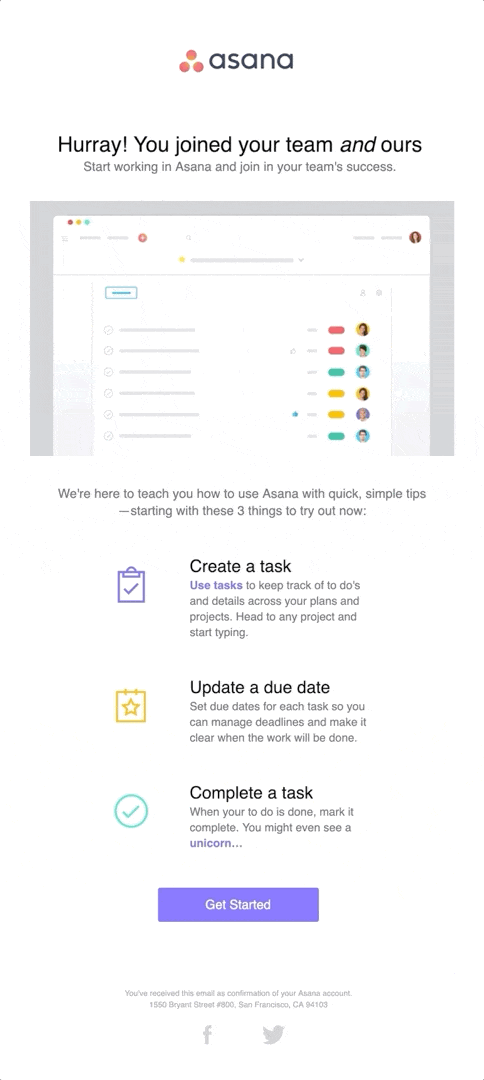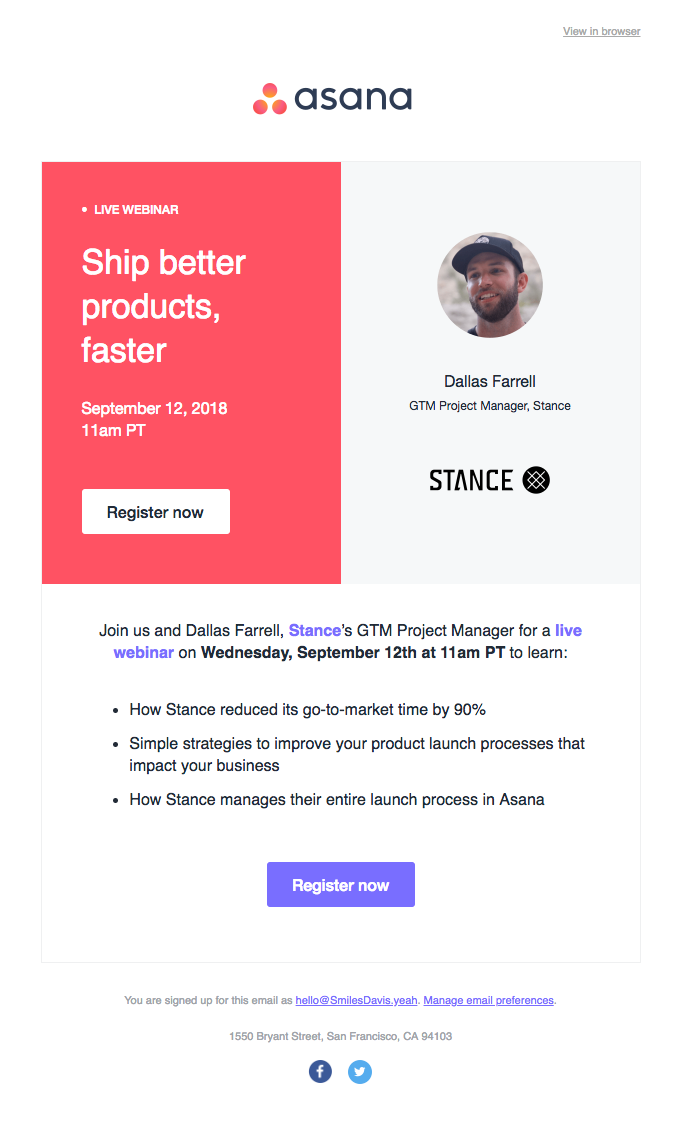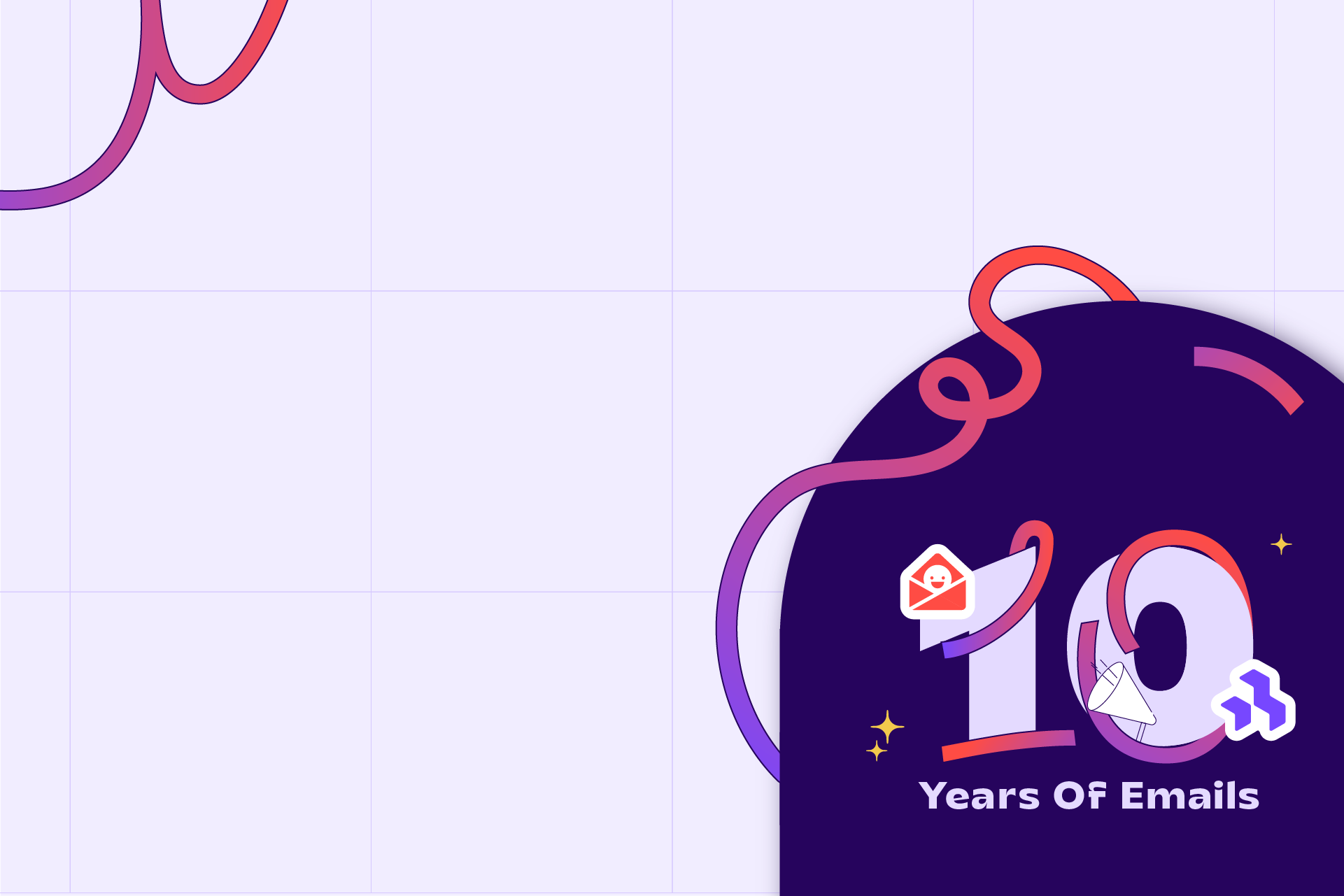A bit about Asana (in case you have been living under a rock)…
Asana is a web platform that is focused on helping teams track their work and get more shit done. What that means is that their app keeps track of your teamwork and projects so you or your team can hit your deadlines and get results. We use it. That’s why we reached out to Reigan to see how they design, use and deploy email.
Thanks for joining us, Reigan! What’s your role at Asana?
I lead our Lifecycle and Email Marketing program, which means I’m responsible for moving users through key touchpoints of our marketing funnel after they sign up. That includes onboarding new users, growing customer engagement, encouraging users to upgrade to the Premium version of Asana, and reactivating lapsed users. A lot of that is achieved through email. And I work with some super talented designers and developers to make it happen.
So what’s a core email marketing principle at Asana?
The core of our brand is “Empowering teams to do great things together.” We keep this in mind when crafting email concepts, writing copy, designing, thinking about cadence, etc. With every email we send, our main objective is to deliver value and help teams get results.
Yeah, we love Asana emails. They are pretty sexy. How do you tactically apply your brand principles to campaign planning?
We have four brand attributes — empowering, purposeful, quirky, approachable — that we weave into all of our marketing efforts. We’re always calibrating against these attributes in our emails. At Asana, you’ll often hear things like, “Is this content purposeful? Does it deliver enough value?” or, “Is this line of copy approachable?” or, “Should we dial down the quirk?” This set of attributes ensures that each email is valuable for the user while being a strong reflection of our brand. For email in particular, we get better results when we prioritize the “purposeful,” and then balance the rest according to our goals, audience, and segmentation for each campaign.
Let’s talk more about that. What emails do you use to engage with your customers?
We send three types of emails:
- Transactional: Think updates on tasks and projects
- Marketing Campaigns: Onboarding, drip, newsletters
- Blog Subscriptions: Updates
Our transactional emails keep customers updated on the progress of tasks and projects. They also play a big role in onboarding by helping customers transition from what’s familiar (working entirely in email) to getting things done in a new way in Asana. These notifications help customers become comfortable with how the product works; ultimately they might even feel empowered to turn them off and rely solely on Asana to get updates. It sounds counter-intuitive, but we love when that happens — it means our customers are really embracing the product.
Our marketing emails aim to make our customers’ lives better. As I mentioned, we prioritize delivering value above anything else. For new users, this involves communicating how product features can help them track their work better and get more done. For customers who already love Asana, we use email to help them collaborate better across teams and their company. When more people at a company use Asana, the more value each individual gets from the tool.
 Asana’s full-blown blog email — in its entirety instead of linking back to the site.
Asana’s full-blown blog email — in its entirety instead of linking back to the site.
We also use email to share insights on how to work better in general — even if it doesn’t involve using our product. We offer subscription of two blogs: the Asana blog, which is product and company-focused, and Workstyle, where we share lessons on leadership and teamwork. We do it a bit differently though. When users subscribe to our blog, we email them a full article. We prioritize user experience by delivering the content right in the email to save users a click. Plus, it helps us widen our content distribution.
We A/B tested sending full articles versus just a preview of the article that drives to our blog, and the full article had a 145% higher forward rate. (See example above.)
What’s your strategy for user onboarding emails?
We segment and test. For example, we segment onboarding emails for customers who proactively signed up for Asana versus those invited by teammates. We also segment emails based on whether a customer’s first Asana experience is in our mobile apps or our web app. Those groups come to Asana with very different mindsets, so we have to explain our product and encourage them in much different ways. We run A/B tests within these key segments and switch up subject lines, content, frequency, and targeting regularly.
Also, onboarding emails aren’t just for new users. We recently tried an onboarding series for customers who are re-engaging with Asana again after long periods of inactivity and will be testing more of this in the future.
Since we are talking about onboarding, how is Asana capturing new customers in any way that involves the email platform?
Great email marketing also supports Word of Mouth growth. If customers are excited to share our emails, it means we’re delivering value.
We examine forward rates as another indication of whether our content was successful. And we also see a lot of customers sharing our email creative or links to content on social platforms. In fact, we actively monitor Twitter when sending large campaigns to get real-time feedback. The interaction between email and social channel has become increasingly important, and gives us more data points to evaluate performance.
Shifting gears here. What are some things you’ve learned in your career? Examples?
There are a few.
Clicks, opens, and unsubscribes are only half of the story when measuring success. Over the past few years, we’ve become better at measuring our emails’ effect on long-term engagement within our product. Initially, we thought that topline email metrics would be a strong signal for in-app engagement, but we’ve found that the two aren’t always correlated. This email [below] is a good example. The click-to-open rates weren’t encouraging, but when we looked at in-product metrics, we actually saw a 105% w/w lift in usage of Asana integrations. If we had judged this email based on clicks alone, we would have had a very different impression of its effectiveness.
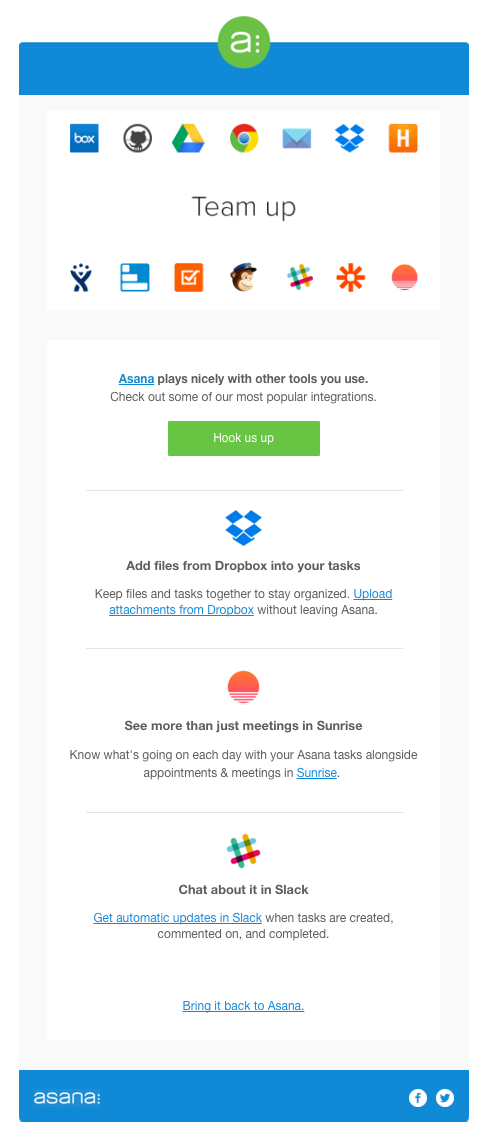
An email can drive engagement post click that is more valuable than the click in itself.
Sometimes, the best way to get lapsed users back into your product is to not push your product at all. We’re in the business of helping teams working better together, and we’ve found that emails featuring thought leadership content from our Workstyle blog have been as successful (sometimes more so) in reactivating users as product-focused emails. When you demonstrate that you can add value in a lighter-weight way and build trust, users might be more willing to give your product a second look. For example, emails like this one [below] drove to our Workstyle blog, yet we saw a significant number of users come back to the Asana product after clicking through.
 Sometimes not pushing your product is more powerful than actually pushing it.
Sometimes not pushing your product is more powerful than actually pushing it.
Less is more, and a little delight goes a long way. It’s pretty basic, but our best performing emails have been clean with a clear layout, featuring one strong CTA and showing the reader exactly what they’re going to get. If a user opens an email, we try to reward them with a little fun (yes, we got GIF game).
Lastly, we’ve also taken lessons from our best-performing marketing campaigns and applied them to our transactional emails. For example, we designed our “task update” email from being a long history of every action to just a brief notification of what changed, and added really clear CTA buttons that link directly to the task in Asana. These redesigned emails were much shorter, had clearer pre-header text, made better use of imagery, and were more consistent with our marketing email style. We found that the redesigned emails performed significantly better, increasing email opens by 36% and CTR by 50% within two months.
Asana has to use its own platform in the project management of your email strategy, right? I think a lot of emailers have troubles with that process. Can you show us how you use it to make that process better?
Asana itself plays a huge role in our email execution and makes it much easier to manage all of the moving pieces. here’s how we like to do it:
#1. We use an Asana project to keep track of new emails or updates we’re launching across the funnel, goals, and ideas of new campaigns:
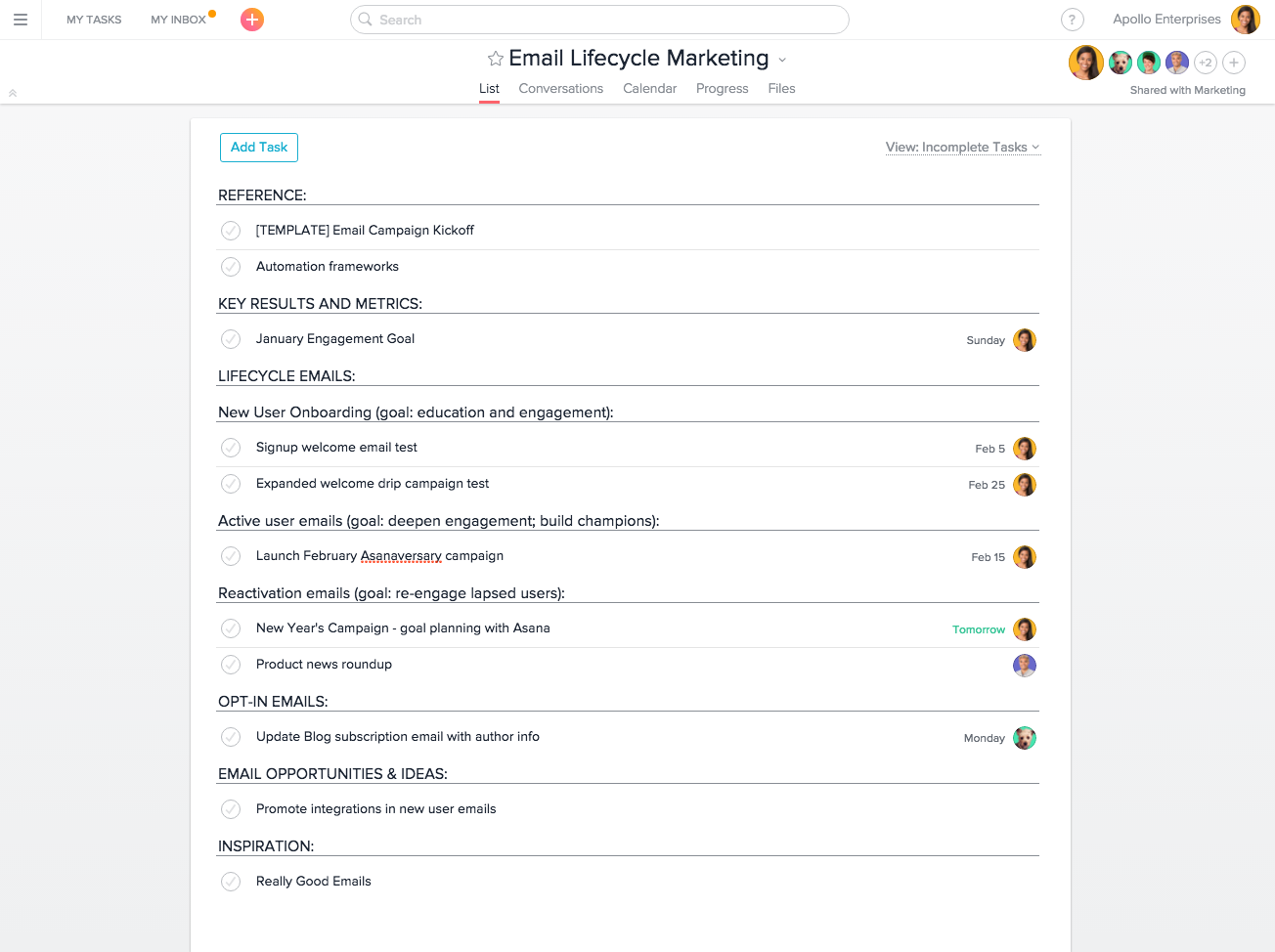
The project is shared with members of our Marketing, Design, and Dev teams so they can stay updated on our campaigns and tests, or add new ideas for future emails. We have sections for key lifecycle stages, so at a glance, we know what we’re testing or tweaking across the funnel.
#2. We use a template task to streamline planning and execution
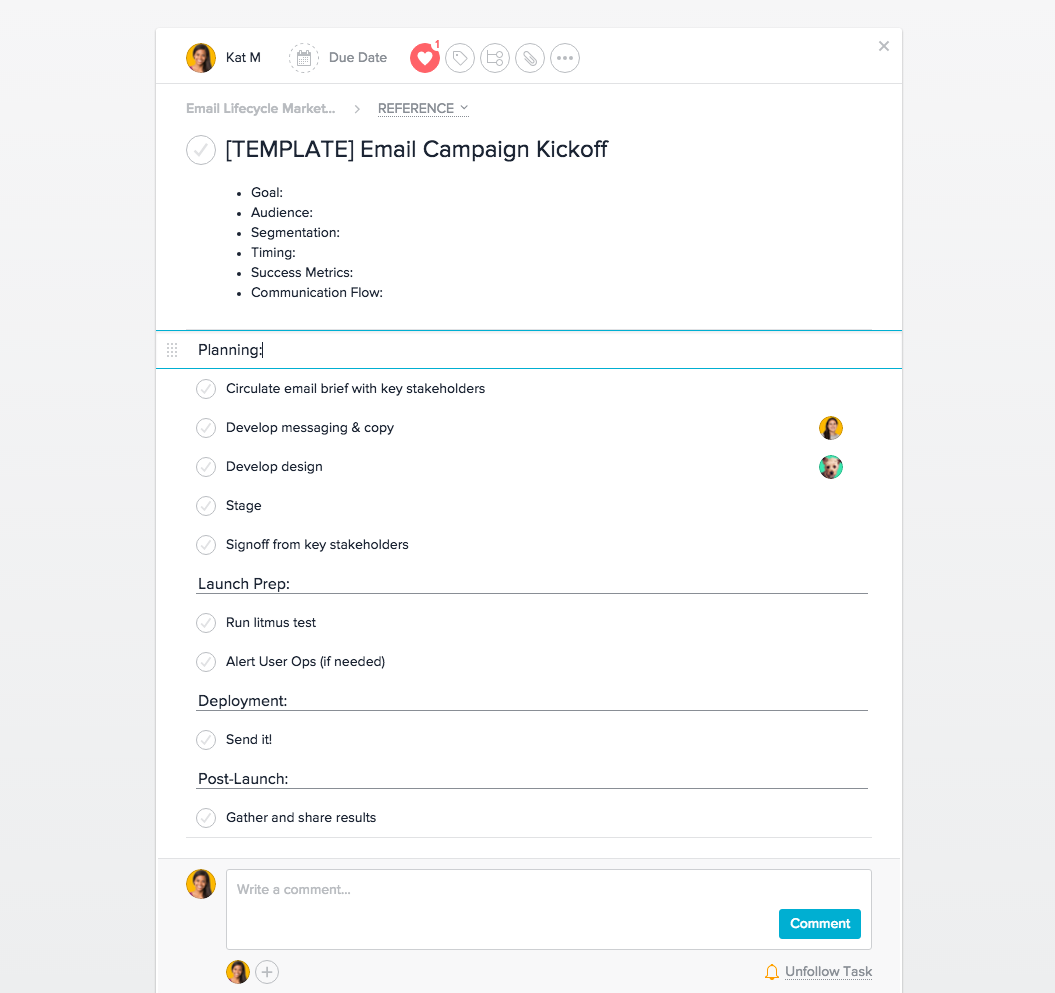
After we honed in on a process for launching emails, we create a template that we copy for each campaign kickoff.
We then outline goals, audience, segmentation, etc. in the task details. Then, we use subtasks to map out what needs to get done, who’s doing it, and by when. This template save us a ton of time, and makes handoffs between Marketing Design and Developers super easy.
#3. We manage design and copy reviews in a task, too.
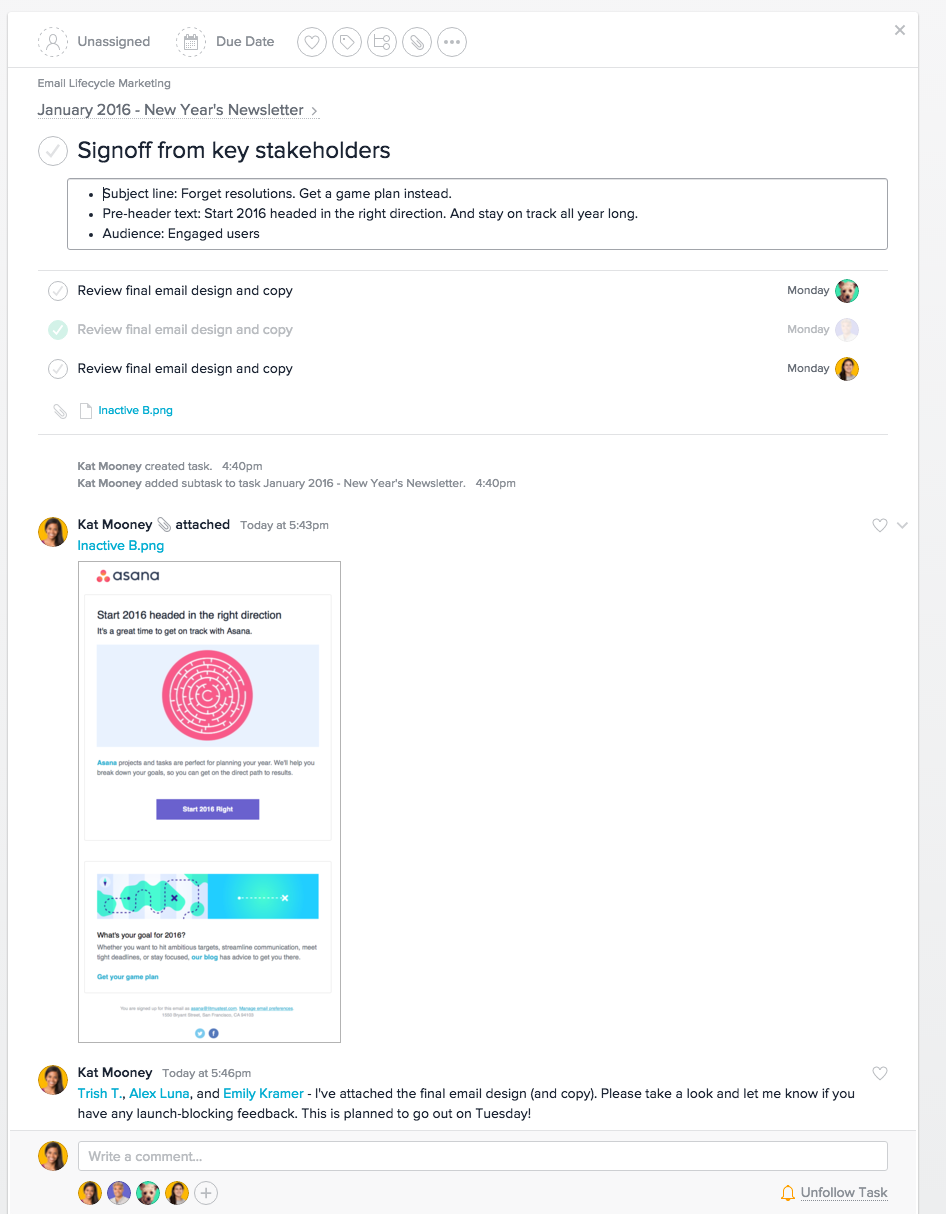
At Asana, emails are very collaborative. For big sends, we open up reviews and feedback to a group of stakeholders to ensure that we have strong goals, design, copy, post-click experiences, etc. We streamline this by making review tasks — we attach creatives to a task and then assign subtasks for stakeholders to leave feedbacks.
#4. We gather all results and insights in an Asana project
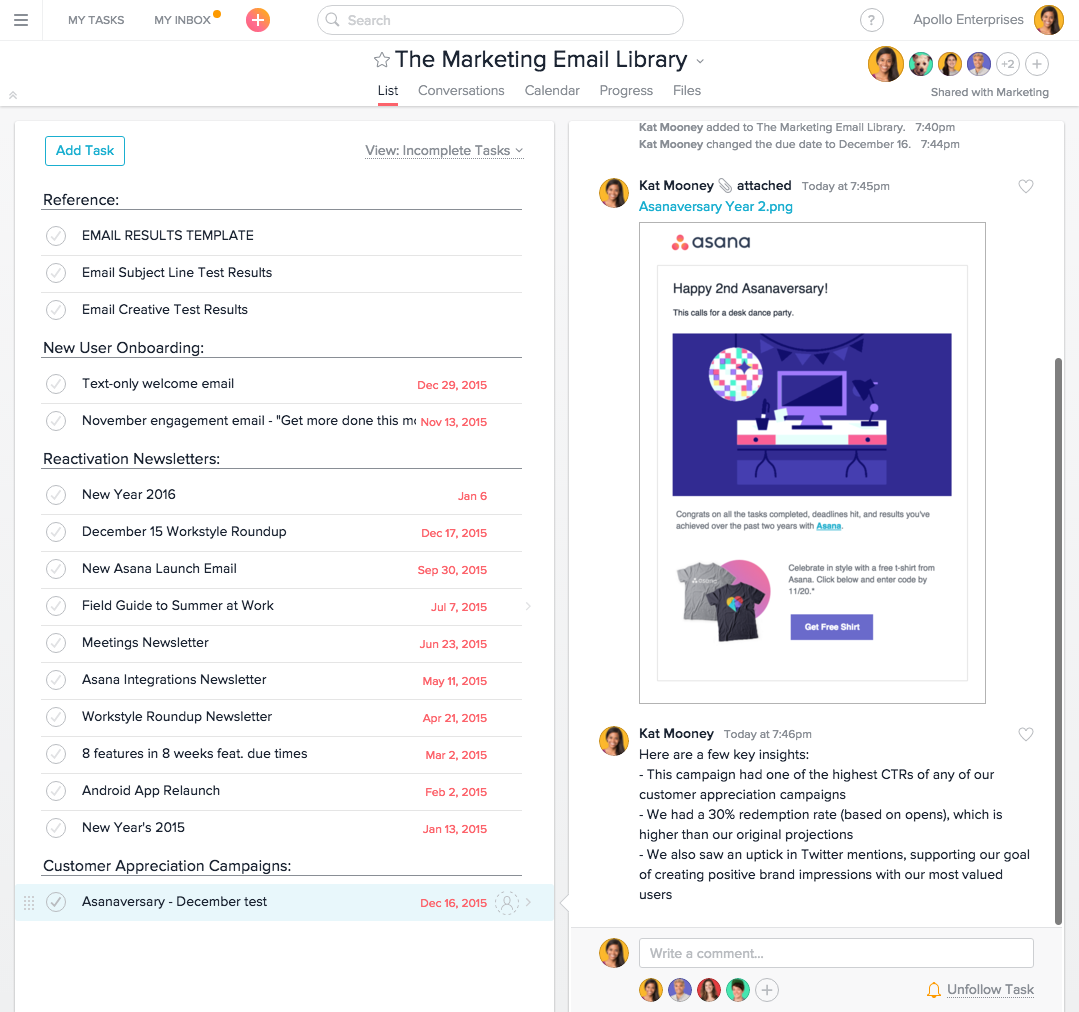
We add all of our email results to a single Asana project. We enter a task for each email, attach the final creative and add metrics and insights to the task details. I add the designer, developer, copywriter, and any other stakeholder to the task and we comment about what worked well (or what didn’t).
This project is shared with members of our Product, UXR, Customer Success, and Sales teams so they can stay informed of customer insights too.
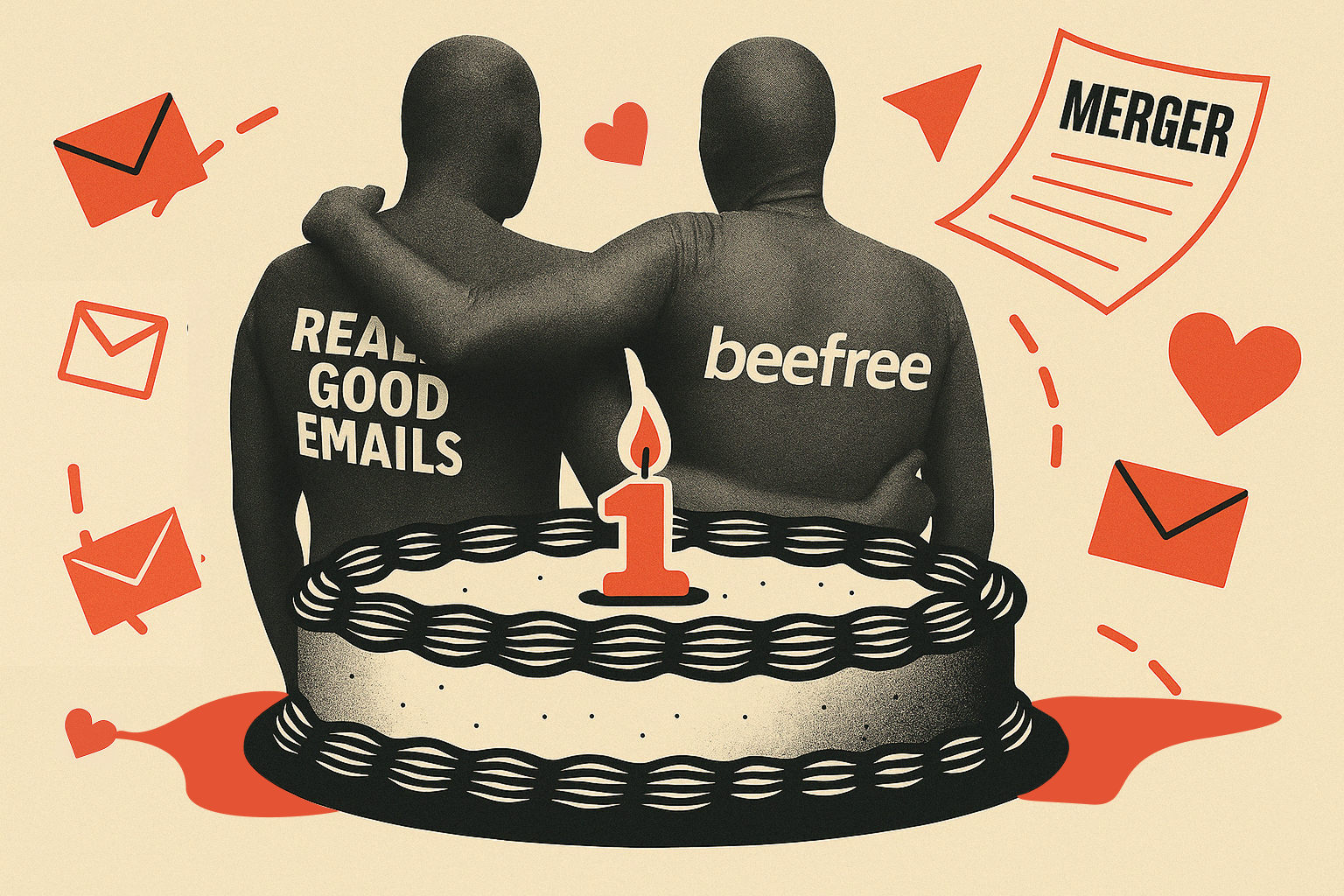

 Asana’s full-blown blog email — in its entirety instead of linking back to the site.
Asana’s full-blown blog email — in its entirety instead of linking back to the site.
 Sometimes not pushing your product is more powerful than actually pushing it.
Sometimes not pushing your product is more powerful than actually pushing it.